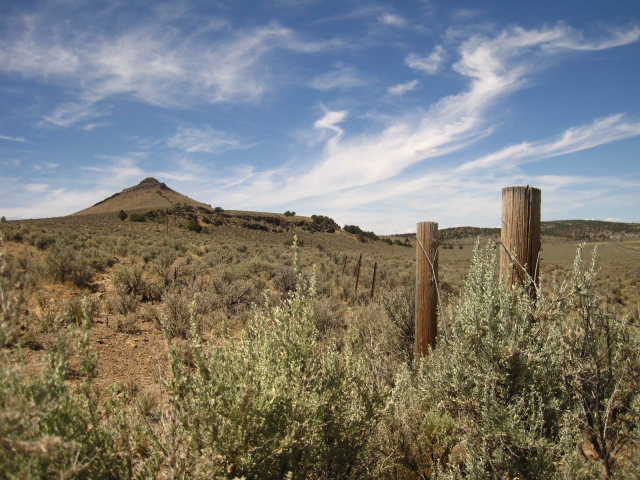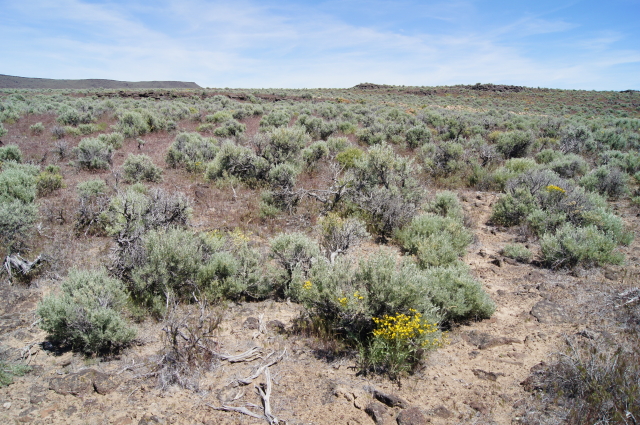Maintaining the Good
Due to the complex nature of the threats facing the sagebrush ecosystem, and our limited ability to restore degraded systems, we believe a top priority for conservation and research is to focus on how to “keep the good stuff good”. Maintaining areas of intact sagebrush rangeland (state A) provides the greatest benefit with the least amount of resources. Below are research projects focused on maintaining state A. To learn more about state A rangelands and Threat Based Land Management visit www.sageshare.org/. Members of the Sage Habitat Team are currently working with a multi-agency collaborative group to develop a similar threat based land management framework to assess threats to mesic systems in sagebrush country and in sage grouse habitat.

Contemporary Grazing in Sagebrush Country
Grazing seasons of use effects on the sagebrush steppe ecosystem:
Extensive reduction and fragmentation of the sagebrush ecosystem has generated an intense focus on how remaining intact sagebrush habitats should be managed. Livestock grazing is the predominant land use in the sagebrush ecosystem but surprisingly, limited information is available for understanding the influence of the direct and indirect effects of common contemporary grazing practices on the sagebrush ecosystem over both short and long time scales.
- We are conducting a long-term replicated experiment focused on three common grazing regimes in the Great Basin: dormant season grazed, spring-defer rotationally grazed and grazing exclusion at a moderate utilization of bunchgrasses in 15-20 acre pastures.
- Status: Currently transitioning the project into long term monitoring after completion of one year of pre-treatment data (2017) and, 4 years of treatment application and post-treatment data collection (2018-2021).
- Anticipated publications:
- Influences of Moderate Levels of Rotational and Winter Grazing on Subsequent Year’s Sagebrush Habitat Characteristics
- Sustainable Grazing Practices for Sagebrush Rangelands
Grazing and Wild Horses
Season Long Horse Grazing in Sage-Grouse Habitat
Fourteen of Oregon’s seventeen Horse Management Areas (HMAs) located in sagebrush rangelands overlap either partially or entirely with BLM’s preliminary priority sage-grouse habitat, with the core distinction indicating the highest quality grouse habitat. Currently there is a high degree of uncertainty regarding wild horse grazing impacts to grouse habitat and population metrics. Preserving these core habitat areas is a top conservation priority, and we need a science-based understanding of horse impacts if we wish to mitigate any potential negative effects to grouse habitat.

- We have initiated a concentrated horse grazing study on private land
- Status: We are using a case study approach to determine the impacts of season-long (8 months/year) horse grazing on
- Sage-grouse nesting habitat structure and composition and
- Currently collecting several years of pre-treatment data before applying the season long horse grazing treatment
Restoration
While preserving intact habitat provides the highest return on limited resources, preventing the degradation of habitats on the brink of persistent conversion to an undesired state is the next highest priority. These habitats still provide some measure of use for wildlife and ranchers, but are at high risk of being lost with a single disturbance event, such as fire.

Restoring habitats on the brink of persistent degradation
One of the highest priority management challenges is restoring perennial vegetation in habitats that still have sagebrush but lack a productive and resilient understory needed to resist invasion in annual grass prone areas of the ecosystem. These areas often provide important connectivity between intact habitats and still potentially service certain habitat needs of sage-grouse and other sagebrush obligates. However, these areas are also at the highest risk for a persistent conversion to exotic annual grassland following disturbance. We also know the least about potential viable conservation measures for these degraded habitats. As such, we have implemented a study that is evaluating the efficacy of various pre-fire and post-fire conservation measures for restoring a perennial understory in degraded sagebrush habitats. We have applied treatments and collected several years of post-treatment monitoring.
Shrub Management Techniques for Increasing Habitat Productivity and Wildfire Resilience of Depleted Wyoming Big Sagebrush Plant Communities

We are implementing research investigating the efficacy of varying sagebrush reduction levels, accomplished with tebuthiuron treatments, for stimulating desired perennial understory responses and improved wildfire resilience in degraded Wyoming big sagebrush rangelands. In 2021, study plots were established and baseline vegetation data were collected in summer, and shrub reduction treatments were conducted during fall. Seeding of native perennial grasses and forbs is planned for March 2022.
Fostering Collective Action through Shared Understanding of Fire Risk Factors and Outcomes in Rangeland Communities

We are engaging in work to help build collaborative capacity for cross-boundary wildfire risk mitigation on southeastern Oregon’s rangelands by developing programming and outreach that offers a venue to create shared understanding of fire risk and outcomes among rangeland stakeholders. To do this, we first need to better understand different perceptions of fire risk factors and associated outcomes currently present among rangeland stakeholders, as well as the social and biophysical conditions that inform those perceptions. Thus, we are conducting an investigation of perceptions of wildfire risk and outcomes associated with varying rangeland fuels conditions among a diverse set of northern Great Basin sagebrush rangeland stakeholders and managers. We will leverage the common fire risk indicators and tolerance thresholds for fuels conditions learned from the investigation to establish guidance and mapping products to support fuels management decisions and associated modifications that reduce fire risk and/or improve fire resilience on northern Great Basin rangelands.
